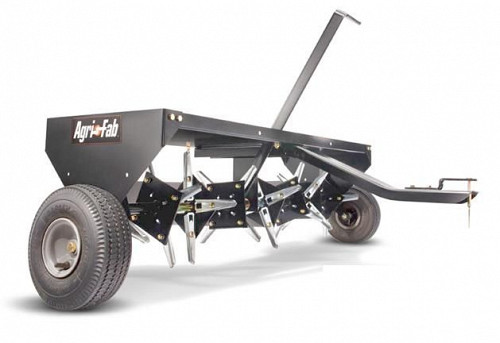Lawn Aerator Benefits and Tips
Do you want a healthier, greener, lusher lawn? If your grass is looking less than its best, it probably needs a little extra TLC. Careful watering, mowing, and fertilizing are all good. But one very valuable (yet easy and affordable) form of lawn care that you might not know about is treatment with an aerator. What is a lawn aerator and how does it help? We’re glad you asked ….
What does a lawn aerator do?
Simply put, an aerator is a piece of landscaping equipment designed to make tiny holes in your lawn … or rather, in the soil under your lawn. This process easily, safely, and naturally amends compacted soil – soil which has been compressed by heavy pressure from foot traffic or vehicles such as cars or riding mowers. Compaction is commonest with clay and loam soil types, although even sandy soil can become compacted, after construction, for example. Aeration loosens compacted soil, with several positive results:
- The soil is easier to dig and to till
- Water, air, and nutrients penetrate the soil better to nourish your grass roots
- Water runoff and puddling are reduced
- Heat and drought tolerance are increased
- Plugs of earth removed by a core aerator decompose into a beneficial layer of “top dressing” for your soil
- Your lawn is healthier and better-looking
Types of aeration equipment
You’ll find several types of lawn aerator for sale or, in some cases, for rent at home and garden centers. These range from inexpensive hand-held tools to deal with small areas, to manual or gas-powered pull behind aerator units, and heavy-duty wheeled versions that you hook up to a tractor. You can even run around in a pair of strap-on spiked shoes that will aerate your lawn and give you a workout at the same time! For best results, though, choose a core aerator (also known as a plug aerator, because it removes small “cores” or plugs of earth) rather than a spike aerator (which just pokes holes in the soil … and can lead to further compaction problems).
Lawn aerator tips
- Aerate annually if your lawn has heavy traffic; otherwise aeration every second year is recommended.
- The best time to aerate is during the spring-to-fall growing season. Aerate lawns with cool season grass in early spring or autumn, and warm season grass in late spring through early summer.
- A lawn grown from sod installation will benefit from aeration to break up layering.
- Choose a lawn aerator that will remove plugs 1/2 to 3/4 inch in diameter and 2 to 3 inches deep.
- Use the lawn aerator on moist soil (the day after watering or rainfall) for optimal results.
- Overseed immediately after lawn aeration to fill in a patchy plot of grass. Follow up with watering and fertilization.
- Consult a landscape professional to set up a regular lawn care program in addition to aeration treatment.
Laura Firszt writes for networx.com.
Looking for a Pro? Call us (866) 441-6648

Average Costs
Related Experiences

Attic Stairs Install – High Quality, Reliable Service, Good Price

Concrete Patio Is The Finishing Touch For An Artist's Studio




